 Image search results - "hira" Image search results - "hira" |

Bird's eye view of Shirakawa-go from Ogimachi Castle ruins.
|
|

Side view of Wada-ke House
|
|

Shirakawa-go is also a National Important Traditional Townscape Preservation District (重要伝統的建造物群保存地区).
|
|

Path to Wada House entrance
|
|

Close-up of Ogimachi
|
|

Main house on left and latrine on right with large vats to gather fertilizer.
|
|
|

Main house with a recently rethatched roof, making it look very smooth.
|
|

Shirakawa-go 白川郷
|
|

Wada House, Shirakawa-go
|
|
|
|
|
|

Gable openings let light and air come through the attic to foster silkworms.
|
|

A small stream beside the house helps to melt the snow falling off the roof.
|
|
|

Underside of roof made of an A-frame truss structure
|
|

The thatched roof is replaced every 30 years. Every spring, 6 or 7 thatched roofs are replaced in Shirakawa-go.
|
|

Billboard depicting Ki-otoshi (Log Drop) at Shimosuwa Station.
|
|

Shimosuwa Station on May 8, 2004. Here for the final three days of the Onbashira Matsuri's climax, the Satobiki when they haul the Onbashira logs to the Shimo-sha Shrines (Akimiya and Harumiya) and erect them.
|
|

The bottom ends of these beams are pegged into a point (komajiri) resting on another cross beam. Wada House, Shirakawa-go
|
|

It costs several million yen and a small army of workers to replace the thatch. The cost is subsidized by the town, prefecture, and national government.
|
|

Where silkworms were raised to make silk cocoons.
|
|

Shimosuwa Station 下諏訪駅
|
|

Onbashira monument in front of Shimosuwa Station. This Onbashira log was used in the opening ceremony of the Nagano Winter Olympics in 1998.
|
|
|
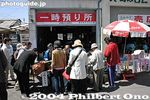
Store your luggage here. Not enough lockers at the train station so they provide this service. 400 yen/day.
|
|

Entertainment stage in front of Shimosuwa Station.
|
|

Slats on the attic floor to enable smoke and soot from the hearth to reach the attic.
|
|
|
|

Go straight on this road in front of the station.
|
|

In front of Shimosuwa Station.
|
|

Straw rope tie the large beams to form a truss for the roof.
|
|

Shirakawa-go 白川郷
|
|

There are no buses nor taxis to where we want to go.
|
|

Parade of Nagamochi which are long chests. 長持
|
|

Another rope made of a crushed tree branch to tie smaller beams. It tightens as it dries.
|
|

Photo gallery
|
|

We had to walk it. This was April 10, 2004, one of the days for Shimo-sha Shrine's Yamadashi when they hauled the logs from the mountain forest.
|
|
|
|
|

After walking for 30 min., we reached this place called Shimekake, a resting place for the logs which had been hauled from the mountains. This is Log No. 2 for Akinomiya Shrine. 注連掛
|
|
|

Implements to raise silkworms.
|
|

Restaurant
|
|

Rethatching a small storehouse.
|
|

The logs will rest here for about a month until early May when they will be hauled to the shrines for the Satobiki erection.
|
|
|
|

Foundation and pillars rest on stones. The beam is shaped to fit the stone.
|
|
|

Here is where anybody can get on the logs and play.
|
|
|
|

Two foundation beams interlock.
|
|
|
|
|
|

Thatch repair work.
|
|
|

After the Shimekake, we walked further.
|
|

Crowded street
|
|

Until we were stopped here. Sign says that only people with tickets can proceed further. Yeah, we walked all this way only to be told we cannot go further. Our destination was the Ki-otoshi slope where the huge logs slide down for the Yamadashi.
|
|
|
|
|
|

We had to wait until the Ki-otoshi at 1pm was over. That's the one we wanted to see. But the place was already too full.
|
|
|
|

We had to wait until the 1pm Ki-otoshi log came out.
|
|
|
|

Nagamochi chest decorations
|
|
|
|

Tourist Information Office in the center of town.
|
|

Log No. 4 for Shimo-sha Shrine's Akinomiya Shrine which already went down the big slope for Ki-otoshi (Log Drop) comes out at 1:30 pm. 秋宮四之柱
|
|
|

Tourist Information Office
|
|

Restroom behind the Tourist Information Office
|
|

Log No. 4 for Shimo-sha Shrine's Akinomiya Shrine. 秋宮四之柱
|
|

Umbrella dance
|
|

Cooling system
|
|

So after this log came out, we were allowed to proceed to the giant slope.
|
|
|

There it is, the slope.
|
|

Shimo-sha Akimiya Shrine torii
|
|

Parking lot along the main road through the village.
|
|

We weren't the only ones there.
|
|

Shimo-sha Akimiya Shrine. That's a support pole for erecting the No. 1 Akimiya Onbashira log. 秋宮
|
|

Deai Bridge crossing the Shokawa River.
|
|
|

The Ki-otoshi slope, and one of the icons of the festival. This is the larger slope for Ki-otoshi compared to the one for the Kami-sha Shrine in Chino. 木落とし坂
|
|

Shimo-sha Akimiya Shrine 秋宮 幣拝殿
|
|

The Ki-otoshi slope up close. Very rough-looking. 木落とし坂
|
|

Hole for the No. 4 Akimiya Onbashira log
|
|

Deai Bridge
|
|

People everywhere along the edge of the slope.
|
|

Small support poles.
|
|

Shokawa River
|
|

Tourist Info Office near the bus stop.
|
|

The numerous people and trees made it impossible to see the slope itself.
|
|

Hole for the No. 2 Akimiya Onbashira log
|
|

Entrance to the Gassho-zukuri Minka-en outdoor museum.
|
|

It was very steep and uncomfortable to sit on, so I decided to leave this place.
|
|

Hole for the No. 2 Akimiya Onbashira log
|
|

Gassho-zukuri Minka-en outdoor museum
|
|
|

Hole for the No. 2 Akimiya Onbashira log
|
|

Gassho-zukuri Minka-en outdoor museum
|
|

I was forced to join this crowd.
|
|
|
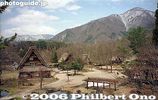
Gassho-zukuri minka houses slated for destruction were moved to this outdoor museum and saved.
|
|

The crowd extended all the way to the rear. All to see the 3pm Ki-otoshi log drop.
|
|

Shimo-sha Akimiya Shrine priests 秋宮
|
|
|

This was my view of the slope.
|
|

Taiko performance at Shimo-sha Akimiya Shrine's Kaguraden
|
|
|
|

Thank goodness for telephoto lenses.
|
|

Shimenawa sacred rope on Kaguraden
|
|

We waited for the log scheduled to come down at 3 pm, but it was delayed by 2 hours...
|
|

Onbashira Grand Park
|
|
|

We sat there for hours.
|
|
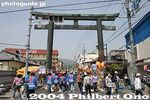
Harumiya torii 春宮大門
|
|

Fire hydrant
|
|

Finally, people pulling the log appeared.
|
|
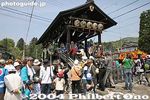
On the way to Harumiya Shrine, you see this bridge. It is a rest stop for the Akimiya Onbashira log procession. 下馬橋
|
|

Manhole in Shirakawa-go.
|
|
|
|

The bridge is normally closed to the public. In the old days, this bridge marked Harumiya Shrine's sacred area where even warlords had to get out of their palanquin or get off their horse out of respect before proceeding further. 下馬橋
|
|

Shirakawa Village Office
|
|

Dam reservoir
|
|

The log pullers split into two.
|
|

Harumiya Shrine ahead.
|
|

Mihoro Dam, made only of rocks and clay. 131 meters high, 405 meters long.
|
|
|

Harumiya Shrine torii 春宮
|
|

Then came the log, and a lotta dust which made it difficult to see what was going on.
|
|

Harumiya has a little slope where the logs are slid down.
|
|

This was Log No. 1 for Shimo-sha's Harunomiya Shrine.
|
|

People everywhere.
|
|

But my camera captured the log going down, even though I could hardly see it. Onbashira Festival, Shimosuwa, Nagano. 木落とし坂 春宮一之柱
|
|

People along the small slope.
|
|

It was over after a few seconds. We walked for an hour from the train station and waited hours for just a few seconds of mostly dust.
|
|

This is May 9, 2004, the second day of Shimo-sha Shrine's Satobiki. Shimo-sha Shrine consists of two separate shrines called Akimiya and Harumiya.
|
|

Now we walked back together with hundreds of thousands of people...
|
|

Ropes to pull the Onbashira log from Harumiya Shrine.
|
|

The Ax Man. He cuts the rope which sets the log loose down the slope.
|
|

Log in Harumiya Shrine.
|
|

The log heading to the Shimekake resting place. If you don't like crowds, don't see this festival. Also see photos of Shimo-sha Satobiki.
|
|

Onbashira Log No. 1 already erected for Harumiya Shrine on May 8, 2004.
|
|

Erecting Onbashira Log No. 4 for Harumiya Shrine on May 9, 2004. 春宮四之御柱
|
|

The Onbashira Festival's main event takes place at four different times in early April and early May, centering on Chino city and Shimosuwa town. It is the festival of Suwa Taisha Shrine consisting of the Kami-sha Shrine and Shimo-sha Shrine.
|
|

Erecting Onbashira Log No. 4 for Harumiya Shrine on May 9, 2004. Shimosuwa, Nagano. 春宮四之御柱
|
|
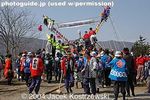
Both the Kami-sha Shrine (in Chino and Suwa cities) and Shimo-sha Shrine (in Shimosuwa town) consist of a pair of shrines. So there are actually a total of four shrines involved in the festival.
|
|
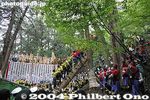
Everything is done with great fanfare, with these men riding on the log as it slowly rises by a system of cables and pulleys.
|
|
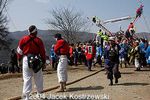
Held every 6 years (1998, 2004, 2010, etc.), this festival brings new logs from the mountain forest to all four shrines where they are erected. Each shrine receives four logs, so a total of 16 logs are cut and hauled to the shrines.Only a rope keeps the log from going down.
|
|

"Yoisa! Yoisa!"
|
|

The hauling of the logs from the forest to a resting place near the shrine is called Yamadashi. The hauling route and schedule for the Kami-sha and Shimo-sha Shrines are different.
|
|
|

The Yamadashi log hauling for the Kami-sha Shrine was held during April 2-4, 2004. Along the hauling route is a slope where the log is slid down while men ride on it.
|
|
|

These photos show the slope for the Ki-otoshi (Log Drop) along the log-hauling route to Kami-sha Shrine in Chino and Suwa.
|
|
|

This log drop is one of the highlights of the festival.
|
|

When the log is erected, a banner is unrolled.
|
|

This is one log about to go down the slope. A total of 8 logs will go down this slope.
|
|

The banner reads, "Thank you everyone for your cooperation."
|
|

The log is dragged to the edge of the top of the slope.
|
|
|
|
|

The log is tilted upward.
|
|

Sake is given for free.
|
|
|
|

At the bottom of the slope is a huge crowd watching the spectacle, Ki-otoshi or Log Drop, Onbashira-sai Festival.
|
|
|

Ki-otoshi or Log Drop, Onbashira-sai Festival.
|
|

The men now descend from the log.
|
|

The slope is near the train tracks.
|
|
|
|

Onbashira Log No. 3 for Harumiya Shrine.
|
|
|
|

The base of the Onbashira log is reinforced by these smaller logs.
|
|
|

Music Box Museum
|
|
|
|

Parade
|
|
|

One Onbashira log at a rest stop.
|
|

Each log is preceded by flag bearers.
|
|

Ropes at rest
|
|
|

The logs are pulled by people from various districts or parishes in the Suwa region including Chino, Shimosuwa, Okaya, and Suwa.
|
|

Another log coming to the slope.
|
|

Another Onbashira log makes its way through.
|
|
|
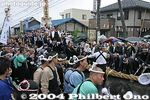
All the Onbashira logs are hauled manually by human hands from when it is cut in the mountain forest. No motor vehicles of any kind is used to haul the logs.
|
|
|
|
|
|
|
|
|

The log can move quite fast, even with all those people riding it.
|
|
|
|
|
|
|
|

This looks like Log No. 2 for Akimiya Shrine.
|
|
|
|

These people are from Suwa city.
|
|
|

Ax man
|
|

The ax man is ready to cut the rope.
|
|
|

In one swing, he cuts the rope.
|
|

Log standing by in front of Akimiya Shrine.
|
|

The rope snaps and the log slides down the slope.
|
|

Onbashira-sai, Shimosuwa-machi, Nagano.
|
|

Another log comes to the slope.
|
|

Log standing by in front of Akimiya Shrine.
|
|

A total of 8 logs are slid down this slope.
|
|
|
|

Parade continues even in the rain.
|
|

Everything is very ceremonial.
|
|
|
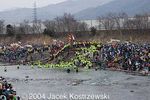
Another obstacle along the route to the Kami-sha Shrine is this river.
|
|
|

This river crossing, called Kawa-koshi, is another highlight of the festival. 川越し
|
|
|

川越し
|
|
|
|
|

Now it's May 10, 2004, the last day of the Shimo-sha Satobiki. All four logs will erected at Akimiya Shrine on this day.
|
|

We waited in the rain for Onbashira Log No. 1 to be erected first at Akimiya Shrine at 10:00 am. However, we had to wait, standing up in the rain and in the crowd, for 2.5 hours before they finally started to raise the log.
|
|

Finally, something to photograph.
|
|
|
|

They threw out free streamers and I caught one. "Yoisa! Yoisa!"
|
|
|
|

They waved their pom-poms and cheered all the while.
|
|
|

Onbashira Festival. They included one woman.
|
|

Banners unfurled.
|
|

Now they descend.
|
|

The only woman on the log. After this log-raising, I had seen enough. This No. 1 log offered the best view of all the four Akimiya logs.
|
|
|

Hira mountains
|
|
| 1196 files on 5 page(s) |
1 |
 |
 |
|